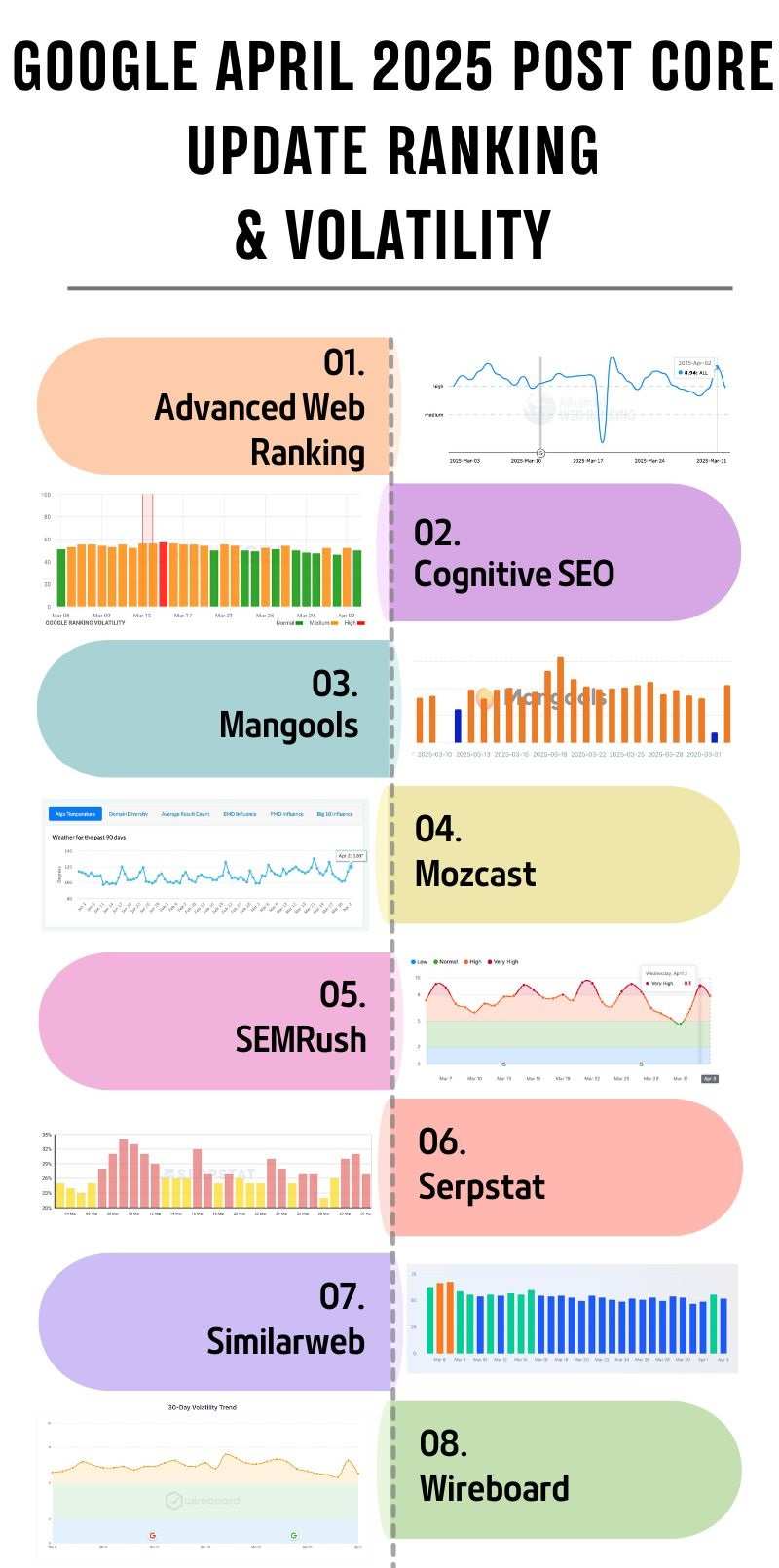Google April 2025 Post Core Update Ranking and Volatility
Google April 2025 Post Core Update Ranking and Volatility
The search engine optimization (SEO) landscape experienced significant turbulence in April 2025, following the completion of Google’s March 2025 Core Update on March 27, 2025. While site owners and SEO professionals anticipated a period of stabilization after the core update, the search results told a different story. Ranking volatility spiked dramatically in early April, sparking widespread speculation about the causes and implications of these fluctuations. This article delves into the nature of the April 2025 post-core update volatility, its impact on websites, potential causes, and strategies for navigating this unpredictable SEO environment.
The March 2025 Core Update: A Brief Recap
Google’s March 2025 Core Update, the first major algorithm update of the year, began rolling out on March 13 and concluded on March 27, taking 14 days to complete. According to Google, this update aimed to “better surface relevant, satisfying content for searchers from all types of sites,” with a focus on rewarding high-quality, people-first content. Data from SEO platforms like Semrush and Similarweb indicated that the update’s volatility was comparable to the December 2024 Core Update, with significant ranking fluctuations in industries such as healthcare, finance, and news media. However, the update was noted to be less widespread than some previous core updates, impacting a more targeted set of sites.
Despite its completion, the March 2025 Core Update left a lingering effect. SEO tracking tools, including Semrush Sensor and MozCast, reported ongoing volatility in the weeks following the update, particularly in early April. This unexpected turbulence led to questions about whether Google was implementing additional unconfirmed updates or if the core update’s effects were still reverberating through the search ecosystem.

April 2025: A Surge in Volatility
Timeline of Events
The post-core update volatility became particularly pronounced starting April 2, 2025, just days after the March update’s completion. SEO tracking tools reported monumental spikes in ranking fluctuations, with some describing the volatility as more intense than during the core update itself. By April 9 and 10, the SEO community noted another wave of significant ranking changes, further fueling speculation about an unconfirmed algorithm update. Reports from WebmasterWorld and social media platforms highlighted dramatic traffic drops, sudden ranking losses, and unpredictable patterns, such as traffic surges followed by steep declines.
For example, one SEO practitioner noted a 50% drop in organic traffic overnight, while another reported a site that briefly recovered rankings on April 4, only to plummet again by April 10. These erratic swings were not isolated incidents but part of a broader trend affecting sites across various niches, from e-commerce to blogging and local services.
Industry-Specific Impacts
The volatility in April 2025 was not uniform across all sectors. Data from SEO platforms indicated that certain industries experienced more significant disruptions:
- Healthcare: The health sector saw substantial ranking fluctuations, particularly in the top five search positions. This aligns with Google’s ongoing emphasis on E-E-A-T (Experience, Expertise, Authoritativeness, and Trustworthiness) for YMYL (Your Money, Your Life) content.
- Finance: The finance industry reported the highest levels of volatility, with sites experiencing dramatic shifts in visibility for competitive keywords.
- Retail and E-commerce: E-commerce sites noted increased impressions but lower conversion rates, raising concerns about bot traffic or algorithmic prioritization of less relevant content.
- Travel: In contrast, the travel sector experienced relatively low volatility in the top three positions, suggesting that some niches were less affected by the post-update turbulence.
These industry-specific patterns highlight the complexity of Google’s algorithm adjustments and the challenges of pinpointing a single cause for the volatility.
Potential Causes of the April 2025 Volatility
The sudden and intense ranking fluctuations in April 2025 have led to several theories about their origins. While Google has not officially confirmed an additional update, the following factors may have contributed to the observed volatility:
1. Lingering Effects of the March 2025 Core Update
Core updates often have prolonged effects as Google’s systems recalibrate and reassess content under new ranking signals. The March 2025 Core Update, with its focus on content quality and relevance, may have triggered a cascade of adjustments that continued into April. For instance, sites that initially benefited from the update may have seen their gains reversed as Google fine-tuned its evaluation of E-E-A-T or user engagement metrics.
2. Unconfirmed Algorithm Updates
SEO experts, including Barry Schwartz of Search Engine Roundtable, reported signs of unconfirmed updates in early April, particularly around April 2 and April 9-10. These updates could involve refinements to Google’s spam detection, indexing behavior, or content quality signals. Google has a history of rolling out smaller, unannounced updates, as noted in their documentation: “We’re constantly making updates to our search algorithms, including smaller core updates. We don’t announce all of these because they’re generally not widely noticeable.”
3. AI Integration in Search
Google’s increasing reliance on AI-driven features, such as AI Overviews, may have contributed to the volatility. During the March 2025 Core Update, AI Overviews saw a significant expansion in the entertainment, restaurant, and travel sectors, with presence growing by 528%, 387%, and 381%, respectively. These AI-generated summaries can alter click-through rates and traffic patterns, even for sites with stable rankings, as they occupy prime real estate on the search results page. The ongoing testing and refinement of AI features in April likely exacerbated ranking fluctuations.
4. Proliferation of AI-Generated Content
The rise of AI-generated content, produced by tools like ChatGPT and Gemini, has created new challenges for Google’s algorithms. Many site owners reported that low-quality, AI-generated articles were outranking original, human-written content, particularly in niche topics. This phenomenon may have prompted Google to adjust its content quality signals, leading to volatility as the algorithm attempted to differentiate between helpful and shallow content.
5. Technical Issues with Tracking Tools
Some of the reported volatility may have been amplified by issues with third-party SEO tracking tools. In March 2025, platforms like Ahrefs and SE Ranking confirmed inconsistencies in their SERP data, which could have skewed perceptions of ranking changes. While Google Search Console remains the most reliable source for tracking site performance, discrepancies in third-party tools may have contributed to the sense of chaos in April.
Impacts on Website Owners and SEO Professionals
The April 2025 volatility had tangible consequences for website owners and SEO professionals, including:
- Traffic Fluctuations: Many sites experienced sudden traffic surges followed by steep declines, making it difficult to predict performance or plan marketing strategies.
- Revenue Challenges: E-commerce sites reported increased impressions but lower sales, suggesting that algorithmic changes may have prioritized less conversion-driven traffic.
- Regional Disparities: Some SEO practitioners noted regional traffic drops, such as decreased Canadian or UK traffic, raising questions about geographic targeting or algorithmic biases.
- Frustration and Uncertainty: The lack of transparency from Google, combined with the unpredictable nature of the volatility, left many site owners feeling frustrated and powerless.
Strategies for Navigating Post-Core Update Volatility
While Google’s algorithm updates can be disruptive, there are proactive steps that website owners and SEO professionals can take to adapt and thrive in this volatile environment:
1. Prioritize E-E-A-T
To thrive after a core update, your website must align with Google’s E-E-A-T standards. Begin by ensuring that all content is created or reviewed by qualified professionals. Add clear author bios that highlight their experience and link to credible professional profiles. Cite high-authority sources and reference industry data to strengthen content credibility. Trust is key, so display transparent business details such as contact information, a thorough "About" page, and an updated privacy policy.
Use HTTPS for secure browsing, and maintain a consistent tone and brand voice across all pages. Content that demonstrates true real-world expertise and reliability builds both search engine trust and user confidence.
2. Focus on People-First Content
Google's core updates now prioritize websites that genuinely serve the user. Avoid writing for search engines. Instead, develop content that offers real value by addressing specific user questions, solving actual problems, and delivering unique insights. Use a clear structure, break up text for readability, and include visuals where helpful.
While AI tools can assist with drafting, all content should be edited and humanized for context and tone. Dive deep into topics that your audience cares about, especially those with local or niche relevance. High-quality, people-first content that aligns with user intent will consistently outperform shallow or generic pages.
3. Monitor Performance with Google Search Console
After a core update, it's critical to closely monitor your site’s performance using Google Search Console. This tool provides accurate insights into impressions, keyword rankings, click-through rates, and more. Focus on how your high-traffic and high-conversion pages perform. Watch for sudden changes in keyword rankings or traffic patterns, and investigate accordingly.
Unlike many third-party tools, Google Search Console reflects real-time data directly from Google, allowing for more reliable decisions. If a page sees a drop, analyze whether the content meets the latest user intent and quality benchmarks. Use these insights to guide your post-update optimization efforts.
4. Audit Technical SEO
Technical SEO issues can be amplified during core updates, so conducting a full site audit is essential. Start by analyzing your site’s speed and Core Web Vitals using tools like Lighthouse or PageSpeed Insights. Ensure your website is mobile-optimized, loads quickly, and uses responsive design. Identify and fix crawl errors, broken links, and redirect chains.
Check indexing status and make sure search engines can access all key pages. Proper use of structured data and schema markup helps search engines better understand your content. A healthy technical foundation supports better rankings and improves user experience, both of which are crucial after an algorithm update.
5. Diversify Traffic Sources
Relying solely on organic search is risky during volatile periods. To safeguard your visibility, diversify your traffic channels. Start by building and nurturing an email list through newsletters and exclusive updates. Leverage social media platforms to engage with your audience and drive traffic through consistent posts and interactions.
Consider paid ads to maintain visibility for key pages. Collaborate with local influencers or businesses to tap into new audiences. Explore alternative SEO platforms like Pinterest or YouTube if they align with your niche. Diversification not only reduces reliance on Google but also strengthens brand presence across multiple touchpoints.
6. Be Patient and Avoid Quick Fixes
Post-update volatility can tempt site owners to make hasty decisions, but patience is essential. Rankings often fluctuate for several days or weeks after a core update. Google advises against making major changes immediately, as your site may stabilize on its own. Wait at least one week before drawing conclusions. Use that time to collect data, assess which pages were affected, and evaluate content quality. Avoid aggressive tactics like mass content pruning or over-optimization. Instead, focus on steady, long-term improvements in user experience, relevance, and value. The most resilient websites are those that invest consistently in quality over shortcuts.
The Broader Implications for SEO
The April 2025 volatility underscores the evolving nature of SEO in an AI-driven, algorithmically complex world. Google’s increasing integration of AI features, coupled with its efforts to combat low-quality content, suggests that volatility may become the new normal. For SEO professionals, this means adopting a more adaptive, data-driven approach that prioritizes user experience and resilience.
Moreover, the proliferation of AI-generated content raises questions about the future of content creation. While AI tools can enhance productivity, overreliance on them risks producing shallow, duplicative content that undermines Google’s goal of surfacing helpful information. Site owners must balance efficiency with authenticity to maintain visibility.

Conclusion
The Google April 2025 post-core update ranking volatility has been a stark reminder of the unpredictable nature of SEO. While the March 2025 Core Update set the stage for significant changes, the subsequent turbulence in April caught many by surprise. Whether driven by lingering core update effects, unconfirmed updates, AI integration, or content quality shifts, the volatility highlights the importance of adaptability and strategic planning.
By prioritizing E-E-A-T, creating people-first content, monitoring performance, and diversifying traffic sources, website owners can navigate this challenging landscape and position themselves for long-term success. As Google continues to refine its algorithms and embrace AI, staying informed and proactive will be key to thriving in the ever-evolving world of search.
For those seeking further guidance, resources like Google’s Search Console and SEO communities on platforms like WebmasterWorld offer valuable insights. If your site was significantly impacted, consider consulting an experienced SEO professional to audit and optimize your strategy. The road to recovery may be challenging, but with patience and persistence, it’s possible to regain and sustain visibility in Google’s dynamic search ecosystem.





